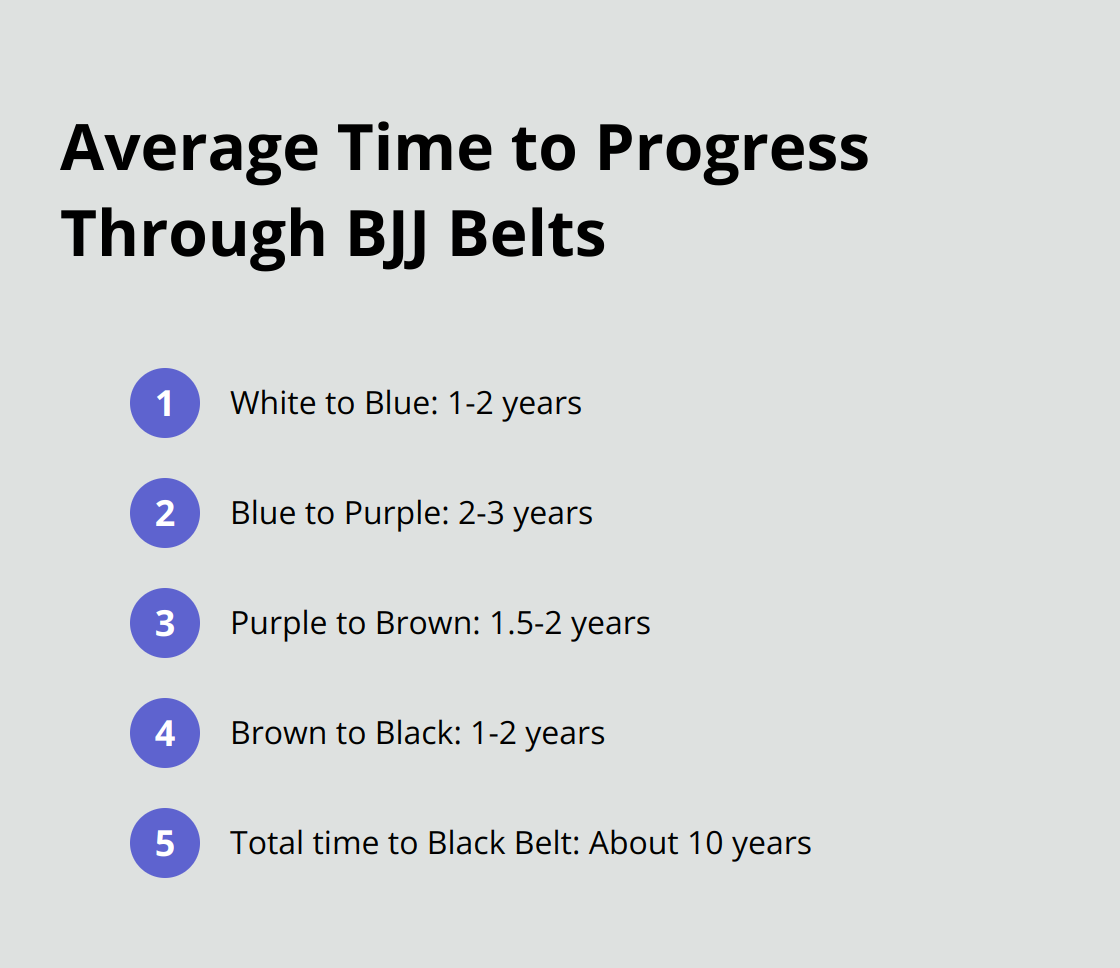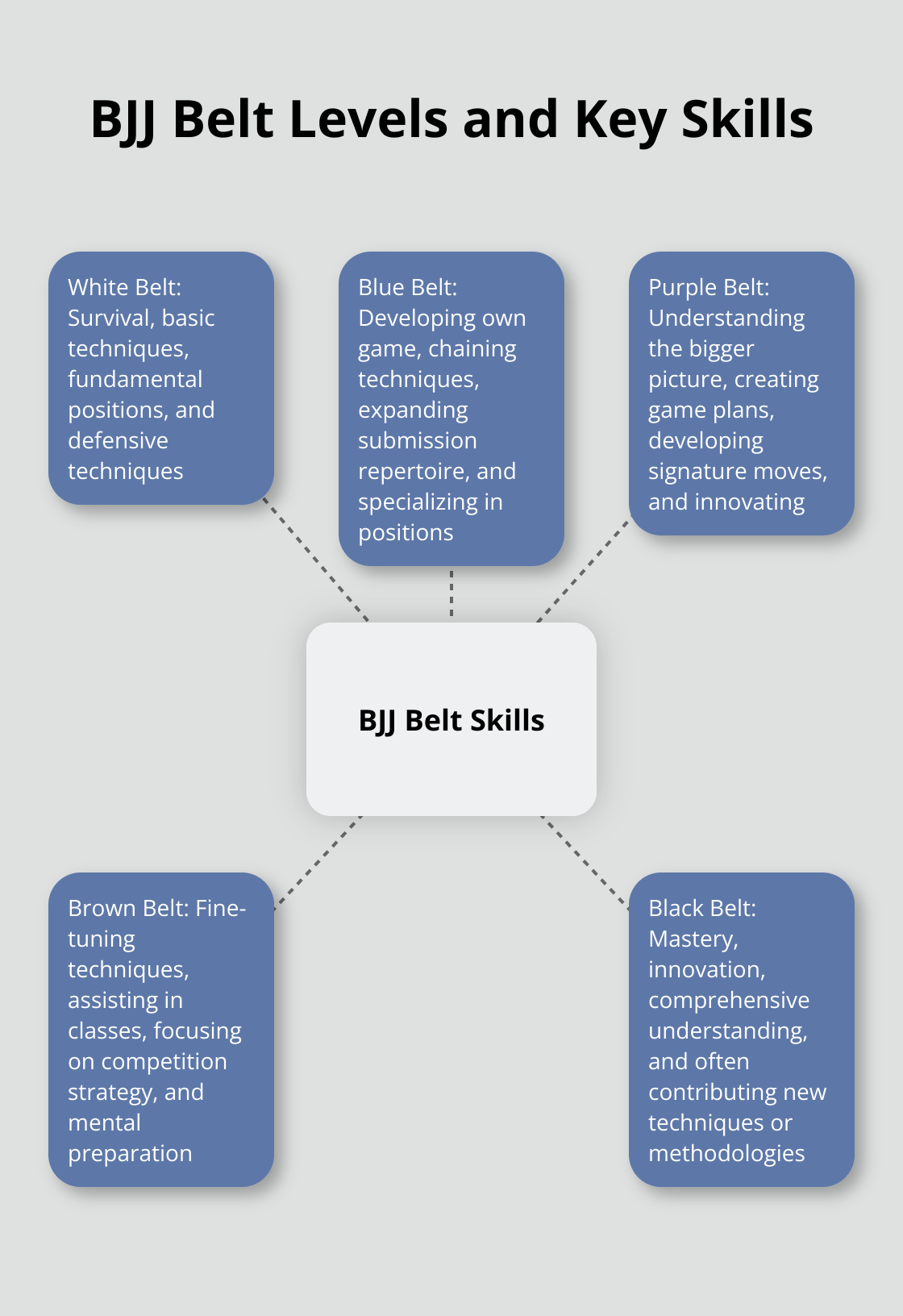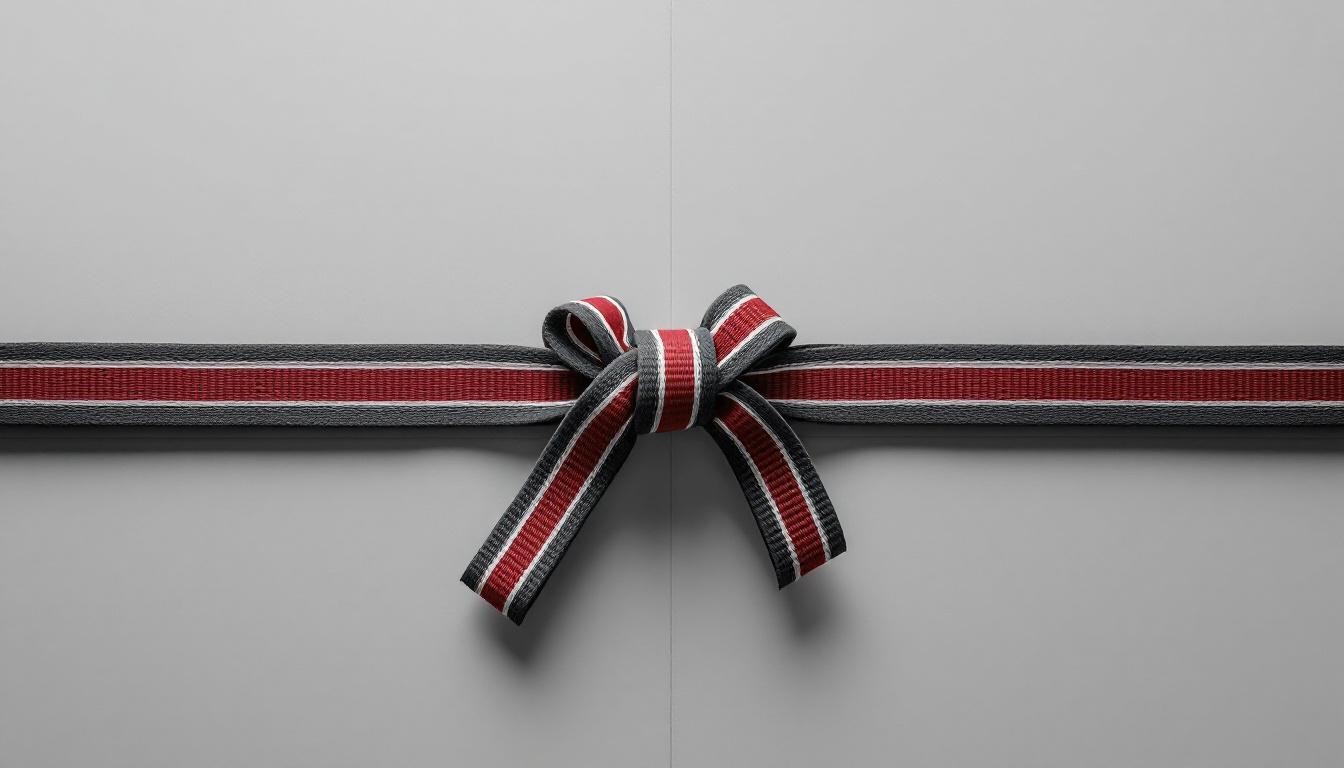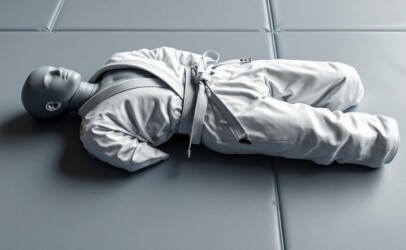At Jiu jitsu, we know that the belt system is more than just a ranking system. It’s a journey of personal growth and skill development.
From white belt to black belt, and even the prestigious coral belt, Jiu-Jitsu practitioners face challenges that shape their character and abilities. This post explores what each belt represents in Brazilian Jiu-Jitsu, both in terms of technical skills and personal development.
What Do BJJ Belts Mean?
The Belt Hierarchy
Brazilian Jiu-Jitsu’s belt system serves as a powerful indicator of a practitioner’s skill, knowledge, and dedication. The adult BJJ belt system consists of five main ranks: white, blue, purple, brown, and black. Each belt represents a significant milestone in a practitioner’s journey. White belts start as beginners, while black belts are considered masters of the art.
Time and Effort
Progression through the ranks requires substantial time and effort. On average, it takes about 10 years of consistent training to reach black belt level. Here’s a rough breakdown:

- White to Blue: 1-2 years
- Blue to Purple: 2-3 years
- Purple to Brown: 1.5-2 years
- Brown to Black: 1-2 years
These timeframes can vary based on factors like training frequency, natural aptitude, and instructor standards. Quality over speed remains paramount, ensuring students build a solid foundation at each level.
Cultural Significance
Belt promotions in BJJ transcend a mere change in color. They mark celebrated events that signify a practitioner’s growth and dedication. Unlike some martial arts, BJJ doesn’t employ standardized testing for promotions. Instead, instructors assess students’ skills over time, considering factors such as technical proficiency, sparring performance, and character development.
Promotion Traditions
The “gauntlet” stands as a common promotion tradition where newly promoted students run through a line of their peers, receiving congratulatory belt whips. While controversial, many view it as a rite of passage symbolizing the challenges overcome to reach the new rank.
Progression and Feedback
A supportive environment allows students to progress at their own pace. Regular feedback from instructors helps students set realistic goals and track their progress. This approach ensures that each belt promotion becomes a meaningful milestone in a practitioner’s BJJ journey.
As practitioners advance through the belt ranks, they not only improve their technical skills but also develop mental fortitude and character. The next chapter explores the specific skills and knowledge associated with each belt level, providing insight into the growth journey of a BJJ practitioner.
Skills and Knowledge at Each Belt Level
White Belt: Building a Foundation
White belts focus on survival and basic techniques. They learn fundamental positions like closed guard, side control, full mount, and back control. Escapes and defensive techniques take priority at this stage. White belts also start to understand the importance of leverage and body positioning.
A typical white belt curriculum includes:
- Shrimping and bridging movements
- Basic submissions (armbar, triangle, kimura)
- Fundamental guard passes
- Proper falling techniques
Blue Belt: Expanding the Arsenal
Blue belts begin to develop their own game. They start to chain techniques together and understand the concept of flow. At this level, practitioners expand their repertoire of submissions and start to specialize in certain positions.
Key areas of focus for blue belts:

- Advanced guard variations (spider guard, lasso guard)
- More complex submissions (omoplata, gogoplata)
- Takedowns and throws
- Defensive strategies against higher-level opponents
Purple Belt: Developing Strategy
Purple belts start to see the bigger picture. They understand how different techniques connect and can create game plans. At this level, practitioners often develop their signature moves and start to innovate.
Purple belt skills include:
- Creating and exploiting angles
- Pressure passing techniques
- Advanced sweeps from various guards
- Leg lock systems (following IBJJF rules)
Brown Belt: Refining and Teaching
Brown belts fine-tune their techniques and often start to assist in classes. They have a deep understanding of BJJ principles and can apply them creatively. Brown belts also focus on competition strategy and mental preparation.
Brown belt focuses:
- Developing a personalized game plan
- Advanced transitions between positions
- Teaching and breaking down techniques for others
- Competition-specific drilling and sparring
Black Belt: Mastery and Innovation
Black belts represent the pinnacle of BJJ skill. They have a comprehensive understanding of the art and often contribute new techniques or training methodologies. Black belts continue to learn and evolve, often specializing in particular aspects of BJJ.
Black belt pursuits:
- Developing new techniques or variations
- Coaching and mentoring lower belts
- Competing at the highest levels
- Contributing to BJJ literature or instructional content
As practitioners progress through these belt levels, they not only improve their technical skills but also develop mental fortitude and character. The next chapter explores how the journey through BJJ belts shapes a practitioner’s mindset and personal growth.
Mental Toughness in BJJ
At Souza Grappling Co., we witness how Brazilian Jiu-Jitsu transforms practitioners mentally. BJJ doesn’t just teach physical techniques; it builds mental resilience and character.

Confronting Discomfort
BJJ forces you to face uncomfortable situations head-on. You learn to stay calm under pressure, whether you’re pinned down (causing claustrophobia) or repeatedly fail a technique. This skill translates to real-life challenges, helping you maintain composure in stressful situations.
A study found that martial arts, including BJJ, encompass a variety of formal movements and traditions that can be practiced for self-defense, competition, physical fitness, and motor development.
Adopting a Growth Mindset
Progress in BJJ is slow, and defeats are frequent. This environment fosters a growth mindset. You learn to view failures as learning opportunities rather than setbacks. This perspective shift proves crucial for long-term success, both on and off the mat.
Dr. Carol Dweck, a Stanford psychologist, emphasizes the importance of a growth mindset. She states, “In a growth mindset, challenges excite rather than threaten. So instead of thinking, ‘I’ll reveal my weaknesses,’ you say, ‘Here’s a chance to grow.'”
Enhancing Emotional Intelligence
BJJ training involves constant interaction with partners. You learn to read body language, manage emotions during intense sparring, and communicate effectively. These skills improve your emotional intelligence, benefiting relationships and leadership abilities in all areas of life.
Overcoming Adversity
Every BJJ practitioner faces setbacks – injuries, tournament losses, or skill plateaus. Overcoming these challenges builds mental toughness and resilience. You learn to persevere through difficulties, a valuable skill for facing life’s obstacles.
Research published in the Journal of Strength and Conditioning Research showed that martial arts practitioners, including those in BJJ, demonstrated higher levels of mental toughness compared to non-practitioners. The study attributed this to the constant problem-solving and adversity faced during training.
Final Thoughts
The journey through Brazilian Jiu-Jitsu’s belt system transforms practitioners beyond the mats. We at Souza Grappling Co. witness the evolution of individuals in technical skills, personal growth, and character development. The path from white belt to black belt (and potentially to the esteemed coral belt in Jiu-Jitsu) shapes resilient, humble, and skilled martial artists.
BJJ emphasizes continuous learning and improvement. Even black belts approach each training session with a beginner’s mindset, always seeking to refine their techniques. This commitment to lifelong learning extends into all aspects of life, fostering a growth mindset that serves practitioners well beyond the dojo.
Souza Grappling Co. provides a supportive environment for practitioners to embark on this transformative journey. Our expert instructors guide students through the challenges of BJJ, helping them grow as martial artists and individuals. The true value lies in the journey itself, not just the destination.




